I am pretty new to OpenCV and am trying to achieve drawing simple contours along the outline of my hand using a webcam. I decided on using cv2.adaptiveThreshold() to deal with the different light intensities when the camera adjusts to the hand moving. Everything seems to work fine except that it is struggling with finding the fingers and then also drawing closed contours.
See here:
I thought about trying to detect a convex hull and detect anything deviating from it somehow.
How do I go about this best? Firstly I need to manage to maybe not find weird closed contours and then go from there?
Here's the code, I fixed the trackbar values for you :)
import cv2
import numpy as np
#####################################
winWidth = 640
winHeight = 840
brightness = 100
cap = cv2.VideoCapture(0)
cap.set(3, winWidth)
cap.set(4, winHeight)
cap.set(10, brightness)
kernel = (7, 7)
#######################################################################
def empty(a):
pass
cv2.namedWindow("TrackBars")
cv2.resizeWindow("TrackBars", 640, 240)
cv2.createTrackbar("cVal", "TrackBars", 10, 40, empty)
cv2.createTrackbar("bSize", "TrackBars", 77, 154, empty)
def preprocessing(frame, value_BSize, cVal):
imgGray = cv2.cvtColor(frame, cv2.COLOR_BGR2GRAY)
# mask = cv2.inRange(imgHsv, lower, upper)
imgBlurred = cv2.GaussianBlur(imgGray, kernel, 4)
gaussC = cv2.adaptiveThreshold(imgBlurred, 255, cv2.ADAPTIVE_THRESH_GAUSSIAN_C, cv2.THRESH_BINARY_INV, value_BSize,
cVal)
imgDial = cv2.dilate(gaussC, kernel, iterations=3)
imgErode = cv2.erode(imgDial, kernel, iterations=1)
return imgDial
def getContours(imPrePro):
contours, hierarchy = cv2.findContours(imPrePro, cv2.RETR_TREE, cv2.CHAIN_APPROX_NONE)
for cnt in contours:
area = cv2.contourArea(cnt)
if area > 60:
cv2.drawContours(imgCon, cnt, -1, (0, 255, 0), 2, cv2.FONT_HERSHEY_SIMPLEX)
peri = cv2.arcLength(cnt, True)
approx = cv2.approxPolyDP(cnt, 0.02 * peri, True)
#######################################################################################################
while cap.isOpened():
success, frame = cap.read()
cVal = cv2.getTrackbarPos("cVal", "TrackBars")
bVal = cv2.getTrackbarPos("bVal", "TrackBars")
value_BSize = cv2.getTrackbarPos("bSize", "TrackBars")
value_BSize = max(3, value_BSize)
if (value_BSize % 2 == 0):
value_BSize += 1
if success == True:
frame = cv2.flip(frame, 1)
imgCon = frame.copy()
imPrePro = preprocessing(frame, value_BSize, cVal)
getContours(imPrePro)
cv2.imshow("Preprocessed", imPrePro)
cv2.imshow("Original", imgCon)
if cv2.waitKey(1) & 0xFF == ord("q"):
cv2.destroyAllWindows()
break

